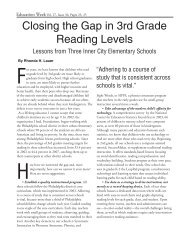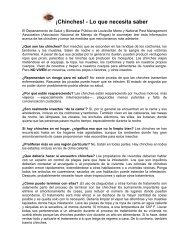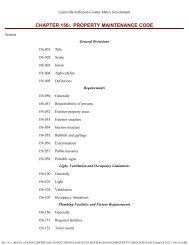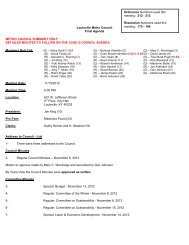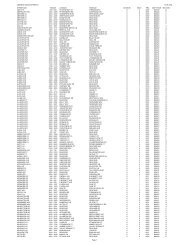Cultural History of Charlie Vettiner Park - Louisville Metro Government
Cultural History of Charlie Vettiner Park - Louisville Metro Government
Cultural History of Charlie Vettiner Park - Louisville Metro Government
Create successful ePaper yourself
Turn your PDF publications into a flip-book with our unique Google optimized e-Paper software.
<strong>Cultural</strong> <strong>History</strong> <strong>of</strong> <strong>Charlie</strong> <strong>Vettiner</strong> <strong>Park</strong><br />
Site Site Type Watershed Diagnostics Reference<br />
15JF674<br />
Arrowhead Farm<br />
(15JF237)<br />
Rosenberger<br />
(15JF18)<br />
Villiers<br />
(15JF110)<br />
Spadie<br />
(15JF14)<br />
Hornung<br />
(15JF60)<br />
open<br />
habitation<br />
open<br />
habitation<br />
open<br />
habitation<br />
open<br />
habitation<br />
open<br />
habitation<br />
open<br />
habitation<br />
Kreinbrink 2005<br />
Ohio River Mocas 1976<br />
Ohio River<br />
McWhinney, Merom-<br />
Trimble, and<br />
Brewerton-like<br />
Ohio River Merom-Trimble<br />
Ohio River<br />
Ohio River<br />
Woodland Period (900 B.C. to A.D. 900)<br />
Lamoka<br />
Brewerton-like<br />
Collins et al. 1979; Jefferies<br />
1990<br />
Collins et al. 1979; Jefferies<br />
1990<br />
Collins et al. 1979; Jefferies<br />
1990<br />
Janzen 1977, 2008; Jefferies<br />
1990<br />
Trends established in the Late Archaic, such as increased social complexity and inequality,<br />
coupled with sophisticated mortuary practices, continued during the Woodland and culminated in<br />
the Adena and Hopewell cultural traditions. In some ways, the Woodland lifestyle was a<br />
continuation <strong>of</strong> earlier Later Archaic and some cultural traditions spanned the Late Archaic and<br />
Early Woodland periods. Technological innovations serve to differentiate the Woodland from the<br />
Archaic as a developmental stage. Among these is the manufacture and use <strong>of</strong> ceramics. The<br />
ungrooved celt replaced the Archaic grooved axe, and bone beamers took the place <strong>of</strong><br />
endscrapers (Railey 1990:248, 1996).<br />
The period is also noted by the appearance <strong>of</strong> social or ritual spaces aside from the domestic<br />
dwellings, including earthen enclosures and burial mounds. Upstream from the Falls <strong>of</strong> the Ohio, a<br />
complex social system labeled Adena appeared in the late Early Woodland around 500 B.C. and<br />
continued into the early Middle Woodland when it intensified into the Hopewell Tradition. The<br />
Woodland period is divided into Early (1,000 - 200 B.C.), Middle (200 B.C. - A.D. 500), and Late<br />
(A.D. 500 - 1000).<br />
Early Woodland (1000 B.C. to 200 B.C.). Differences between Woodland sub-periods<br />
are largely distinguished by changes in ceramic styles. Early Woodland pottery is generally thick<br />
and grit-tempered; vessel exteriors exhibit cordmarking fabric impressions, or are plain. In the<br />
Falls <strong>of</strong> the Ohio region, the grit-tempered cordmarked Fayette Thick is representative <strong>of</strong> Early<br />
Woodland ceramic assemblages (Mocas 1995). Early Woodland projectile points include a<br />
variety <strong>of</strong> stemmed and notched types, including Kramer, Wade, Adena, Gary, and Turkey-tail,<br />
as well as Cogswell Stemmed (Justice 1987). Early Woodland sites in the Outer Bluegrass<br />
regions are found primarily along the region‘s rolling ridgetops particularly near springs and<br />
other critical resources (Railey 1996:85). Domestic structures varied in shape between oval,<br />
circular, square, and rectangular. To the east in the mountain regions <strong>of</strong> the state, these groups<br />
extensively exploited rockshelters and occupied many for long periods <strong>of</strong> time.<br />
Although the emphasis <strong>of</strong> subsistence practices during this period remained on hunting and<br />
gathering, the continued development <strong>of</strong> the horticulture <strong>of</strong> weedy annuals marks a divergence<br />
from the earlier period (Railey 1990:250). Plant species in the Eastern Agricultural Complex<br />
(EAC) tended for their seeds included goosefoot (Chenopodium berlandieri var. jonesianum),<br />
erect knotweed (Polygonum erectum), little barley (Hordeum pusillum), maygrass (Phalaris<br />
16 | P a g e



